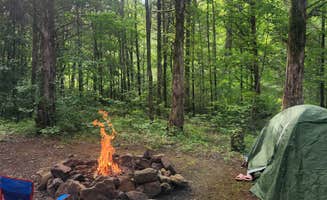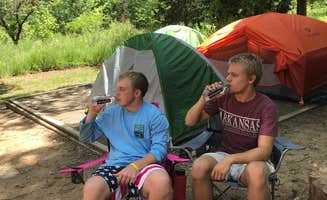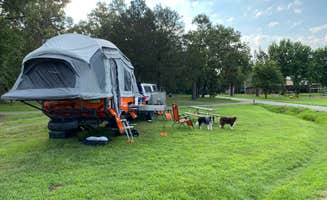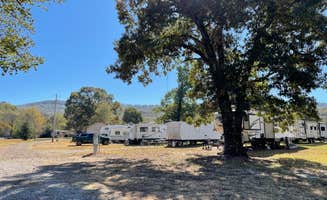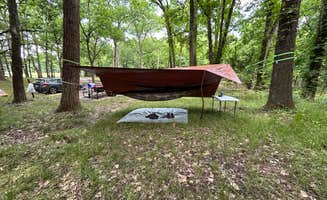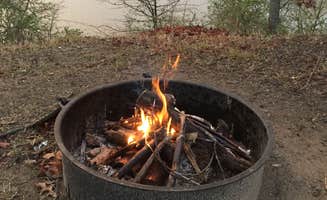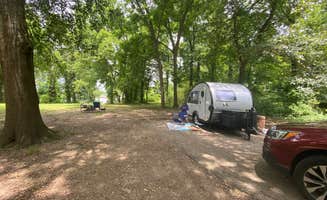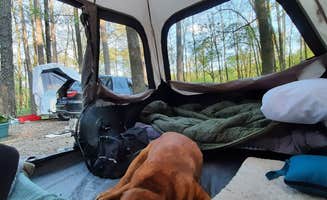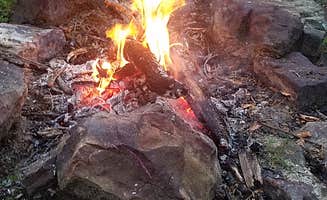Camping opportunities in the Natural Dam vicinity include both established campgrounds and primitive sites throughout the Ozark National Forest. The Natural Dam area sits at approximately 900 feet elevation with surrounding mountains rising to 2,500 feet. Summer temperatures typically range from 65-95°F with winter lows occasionally dipping below freezing, creating distinct camping conditions across seasons.
What to do
Caving expeditions: Devil's Den State Park offers multiple cave systems suitable for different experience levels. "4 days of camping with the guys, exploring caves and trails, and overall having a blast!" notes Brian E. about his Devil's Den State Park Campground experience. The park's cave formations remain at steady temperatures year-round.
Waterfall photography: Morning fog creates optimal conditions for photography at Natural Dam. "It was chilly in the morning, so the fog off the waterfall was eerily gorgeous," mentions James F. from his stay at Natural Dam. Local photographers recommend visiting between 7-9am when light conditions create distinctive patterns through the mist.
Kayaking access: Lake Fort Smith provides boat rentals and water access points. "Lake Fort Smith State Park is a beautiful park in the Boston Mountains. We drove over from Memphis to meet my brother's family. There is a marina where you can rent boats," explains Ryan S. who camped at Lake Fort Smith State Park Campground.
What campers like
Year-round accessibility: While some facilities operate seasonally, many campgrounds maintain core services throughout winter. "Devil's Den is a gorgeous parked tucked in the mountains of Arkansas. The primary campground for RVs is one of the better campgrounds I have seen. The facilities and amenities have been great," shares Gonzo A. about his January visit to Devil's Den State Park Campground.
Fishing opportunities: Multiple water access points provide fishing along the Mulberry River and surrounding creeks. "Right on the Mulberry River, very friendly staff, you can Tube, float, kuyak, or just swim and relax," reports Rick N. from his stay at Mulberry River Outdoor Adventures.
Trail access: Direct trail connections from many campsites allow immediate hiking access. "I would absolutely stay again. The hiking trails were right out of our campsite," notes Jennifer O. from Lake Fort Smith State Park. Many trails feature interpretive markers explaining local geology and plant species.
What you should know
Road conditions: Routes to White Rock Mountain require appropriate vehicles and extra time. "The road to White Rock Mountain driving south on 79 is a minimally maintained one in a half lane dirt road full of rocks, erosion, bumps and a lot of up and down switch backs. My Subaru outback handled it fine, but it takes a full hour to drive less than 15 miles on this road," advises Matt S. about accessing White Rock Mountain Recreation Area.
Water availability: Not all sites provide reliable drinking water sources. "Natural Dam itself lacks amenities like drinking water, trash service, or permanent toilet facilities," explains a local ranger. Visitors should bring at least one gallon per person per day.
Limited connectivity: Cell service remains spotty throughout the region. "There's no cell service whatsoever but Wifi (paid) is offered by the park. Make sure to stock up on supplies beforehand - there are not many options within that area as far as food and services," cautions Gonzo A. about Devil's Den.
Tips for camping with families
Pool options: Seasonal swimming facilities provide heat relief for children. "Aside from the extreme humidity this was a great family getaway. Pool, great trails, and the creek/river kept my kids entertained and worn out!" shares Melissa M. after her visit to Devil's Den State Park.
Site selection: Some campgrounds offer child-friendly configurations. "Many of the campsites are on a grade. They all have multiple levels with stairs and have no railings. We had 5 children <6 years of age and the sites were somewhat perilous. If you are a parent with small kids, sites 17-20 and sites 2-3 are better," advises Ryan S. from his experience at Lake Fort Smith State Park Campground.
Wildlife opportunities: Morning and evening animal sightings enhance educational experiences. "In a prior visit I saw a bear go lumbering in front of my truck on the road to White Rock. Only time in 40+ years I've seen a bear in the wild in Arkansas, and I grew up in the country!" notes Matt B.
Tips from RVers
Site leveling: Select campsites carefully to minimize setup challenges. "Many of the campsites are on a grade. If you need sewer service, I would recommend site #11 as the most level pull-through site, although there's not a bad site in the park," recommends Donna H. about her winter stay at Lake Fort Smith State Park.
Route planning: Avoid steep access roads with larger vehicles. "Nice, quiet place. Great hiking! Not really a place for a quick overnight, the road in is steep and crooked," warns kcki M. from Fort Smith-Alma RV Park, suggesting it as an alternative when mountain roads prove challenging.
Electrical service: Various amperage options exist across campgrounds. "Stayed 2 nights in A Loop. 30 Amp hook up with some of the best water I have ever had. Only 35 ppm on my zero water tester," notes Beverley D. about Springhill campground, which provides an alternative to mountain camping with reliable utilities.


